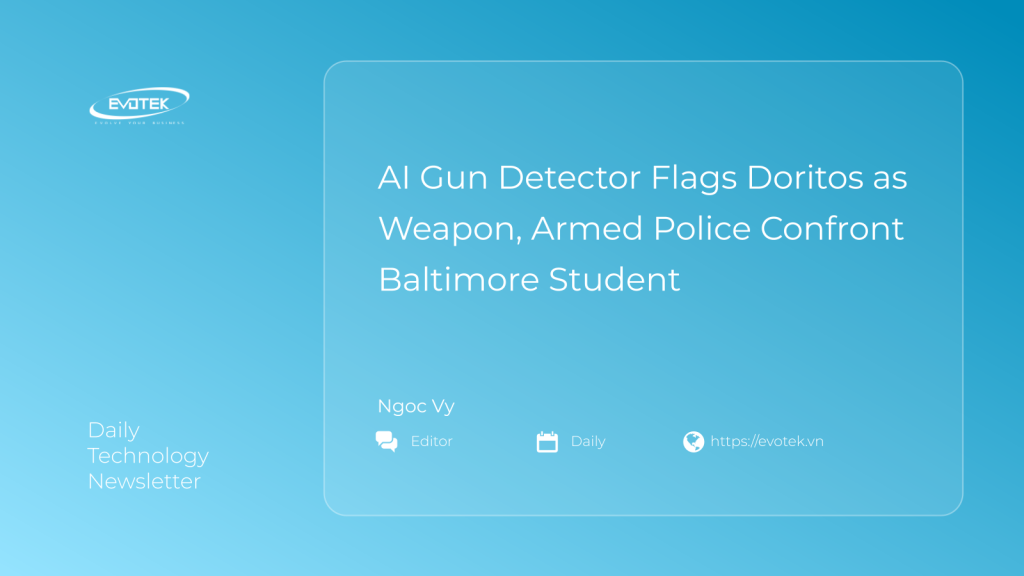A concerning incident at Kenwood High School in Baltimore has ignited fresh debate over AI surveillance reliability in educational settings. Armed police recently swarmed a 16-year-old student after an AI gun detection system mistakenly identified a bag of Doritos as a dangerous firearm, leading to a tense confrontation.
The harrowing event unfolded on October 20 when Taki Allen, 16, was with friends after football practice. Suddenly, multiple police vehicles descended upon them. Allen recounted to WBAL-TV 11 News the chilling moment officers, weapons drawn, commanded him to the ground.
“It was like eight cop cars that came pulling up for us,” Allen stated. “They started walking toward me with guns, talking about ‘Get on the ground,’ and I was like, ‘What?'”
He was forced onto his knees, handcuffed, and thoroughly searched. The officers, finding nothing, eventually revealed the cause of the alarm: an AI-generated image showing a crumpled bag of Doritos in his pocket, misconstrued as a weapon. “It was mainly like, am I gonna die? Are they going to kill me?” Allen shared, describing his terror. “They showed me the picture, said that looks like a gun, I said, ‘no, it’s chips.'”
Omnilert AI System’s “False Positive” and School Response
The technology behind this alarming incident is Omnilert’s AI gun detection system, implemented in Baltimore County Public Schools just last year. Designed to scan existing surveillance footage and issue real-time alerts to police upon detecting suspected weapons, the system’s reliability is now under intense scrutiny.
While Omnilert acknowledged the event as a “false positive,” they controversially asserted that the system “functioned as intended,” claiming its primary role is to “prioritize safety and awareness through rapid human verification.”
Baltimore County Public Schools echoed this sentiment in a communication to parents, offering counseling services to students affected by the ordeal. “We understand how upsetting this was for the individual that was searched as well as the other students who witnessed the incident,” the principal’s letter stated, assuring direct support from school counselors.
Student Fears Returning to School After Traumatic Encounter
Despite the school’s general statement, Taki Allen revealed that he has not received a personal apology or direct outreach from school officials. “They didn’t apologize. They just told me it was protocol,” he explained, expressing his expectation for a more personal follow-up.
The traumatizing experience has left Allen deeply unsettled, making him afraid to return to school. “If I eat another bag of chips or drink something, I feel like they’re going to come again,” he articulated, highlighting the lasting psychological impact of the incident.
Wider Implications: The Growing Debate Over AI Reliability
This incident at Kenwood High School is not an isolated event but rather fuels a broader, urgent debate surrounding the reliability and real-world consequences of AI surveillance tools. The stakes are particularly high when these technologies are deployed in sensitive environments like schools, impacting the safety and well-being of young people.
As AI integration accelerates across various sectors, questions about its infallibility are becoming more prominent. Recent reports indicate that even top military officials, such as Major General William ‘Hank’ Taylor of the US Army, have utilized AI tools like ChatGPT for critical decision-making, underscoring the technology’s pervasive influence.
Furthermore, challenges with AI extend to other applications, like the UK’s new age verification system for mature content. This system, which requires facial scans, has reportedly misidentified individuals, including “Britain’s most tattooed man,” whose tattoos were misinterpreted as a mask, preventing access. Such instances highlight the current limitations and potential for error in advanced AI systems.
The Path Forward: Balancing Innovation and Safety
The ordeal faced by Taki Allen serves as a stark reminder of the critical need for rigorous testing, transparency, and human oversight in the deployment of AI technologies, especially those with the power to trigger armed interventions. As schools and other institutions embrace AI for enhanced security, ensuring these systems are truly safe, accurate, and non-discriminatory remains paramount to prevent future “false positives” from escalating into traumatic real-world experiences.

 日本語
日本語 한국어
한국어 Tiếng Việt
Tiếng Việt 简体中文
简体中文